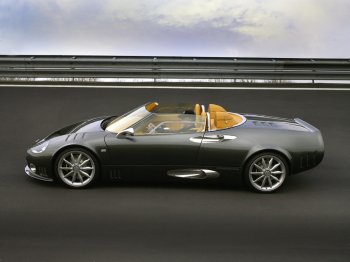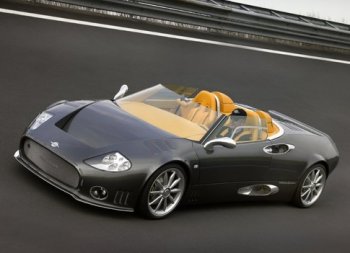|
Dutch exclusive car manufacturer
Spyker will present a
special edition of the C12 during the upcoming Geneva
Motor Show. The sportscar,
the name of which is still unknown, has been penned by
top Italian design house Zagato
The Geneva Motor Show is nearing, and
as with previous editions, the Dutch performance car
manufacturer Spyker has
chosen this show to launch their next exclusive model.
This time it will be a special limited edition of the
C12, a car which has not yet been offered on the market.
The car will have a body designed by
Zagato, and according to
Spyker CEO Victor Muller all
25 examples of this limited edition have already been
sold at a price double that of a standard C12.
Spyker will also present a
driveable example of the D12 Peking-To-Paris, a concept
which Muller presented last year in
Geneva.
The
Spyker story begins back in 1898 when two brothers,
Jacobus and Hendrik-Jan Spijker, coachbuilders based in
Amsterdam, built their first Benz-engined motorcar with
which they won immediate acclaim for the superb
craftsmanship of their bodywork. In the same year
Spijker built the famous golden state coach, still in
use today, to commemorate the forthcoming coronation of
the Dutch queen, Wilhelmina. This was the turning point
in their business career: from that moment on the
Spijker brothers committed their company fully to the
production of motorcars. The business name was changed
to Spyker, for easier recognition in foreign markets.
In 1903 Spyker introduced the extremely
advanced 60/80 HP. It was the first car with a
six-cylinder engine as well as permanent four-wheel
drive and four-wheel brakes. In the same period Spyker
introduced its patented ‘dust shield chassis,’ a chassis
fitted with a streamlined under tray that prevented the
car from making dust on unpaved roads.
Spyker’s image was further enhanced when
in 1907 a privately entered standard model Spyker
14/18HP Tourer became legendary after successfully
competing in the famous gruelling Peking to Paris raid,
arriving in second place. It was innovations as these
that characterized the Spyker cars that quickly became
famous for their quality and the ruggedness of their
engineering. The Spyker models, with their
characteristic circular radiators were especially
successful in the Dutch East Indies and in Britain,
where Spyker became known as ‘the Rolls Royce of the
continent’.
In the period preceding World War 1, a
worldwide slump in the luxury car market meant that
Spyker had to diversify its production and merged with
the Dutch Aircraft Factory N.V. the company started
developing and building fighter aircraft. During the
war, Spyker built around 100 fighter aircraft and 200
aircraft engines. In 1914 the company introduced the
slogan still being used today: ‘Nulla tenaci invia est
via: For the tenacious no road is impassable’. Along
with the slogan came a new logo, featuring a spoke wheel
with a horizontal propeller across. After the war Spyker resumed car
production. True to its motto, Spyker continued building
record-breaking cars. Most famous of these is the Spyker
C4. It had a special engine, built by the famous German
engineer Wilhelm Maybach. It had a double ignition
system with Bosch high-tension magneto and battery-coil
ignition with two spark plugs per cylinder.
The Spyker C4 was a powerful, dependable
and luxurious car. In 1921, a standard C4 (chassis
number C41, engine number 3201) established a new
endurance record, driving continuously for 36 days and
covering a distance of 30,000 kilometres. This car was
called the “Tenax”. Later on it was bought by the Dutch
nobleman Hugo Baron van Pallandt who, with this car, won
the first prize in the hill climb of the Mont de la
Turbie near Monte Carlo in March 1922. The Spyker C12
LaTurbie owes its name to this sporting success. Also in
1922, the famous British driver Selwyn Edge broke the
Brookland’s Double-Twelve speed record, clocking an
average speed of 119 km/h.
|

 |
|
The Spyker C12 LaTurbie made its
worldwide debut during the Geneva Motor Show in
March 2005. It was the first Spyker powered by the
6.0 litre W12 Audi engine. |
|
|
 |
|
Dutch exclusive car manufacturer Spyker will present a
special edition of the C12 La Turbie (above) during
the upcoming Geneva Motor Show. The sportscar, the name of
which is still unknown, has been penned by top
Italian design house Zagato. |
|
 |
|
The Zagato bodied version of the
Spyker C12 La Turbie (above) will have a body designed by Zagato, and according to Spyker CEO Victor Muller
all 25 examples of this limited edition have already
been sold at a price double that of a standard C12. |
|
|
In 1925, the Spyker Company ceased trading, but its name
has never been forgotten. Spyker became an icon, a brand
name that stands for technologically advanced, exotic
and dependable cars. That heritage has been passed over
to the new Spyker company and its cars.
Since October 2000 when the company was revived and the
new Spyker C8 Spyder was unveiled at
the Birmingham Motor Show, Spyker has established a strong
foothold in the super car market niche. Hand-built in the
best tradition of the traditional Spykers by the most
dedicated craftsmen of our time using the very best
materials available. Created with passion for the most
passionate of drivers. The Spyker C8 Spyder won instant
acclaim and was awarded the 2000 Institute of Vehicle
Engineers Design Award on 18 October 2000. The Spyker C8
Laviolette, a coupe reminiscent of modern jet fighters, made
its debut during the Amsterdam Motor Show in February 2001.
Subsequently the Spyker C8 Double12 R, Spyker’s Le Mans
endurance racer, was launched during the IAA in Frankfurt in
September 2001. The street version of the Spyker C8
Double12, the so called ‘S’, was unveiled at the Birmingham
Motor Show in October 2002. In the meantime countless other
concourses d’elegance and events were attended in Europe and
the USA. The Spyker C8 Spyder T, a twin turbo variant of its
C8 Spyder was presented at the IAA in Frankfurt in September
2003. In the 24 Hours of Le Mans 2003 Spyker won its first
victory: finishing 10th in class and 30th overall.
In May 2004 Spyker went public by means of an initial public
offering (IPO), and on 27 May 2004 the car company was
listed at the Amsterdam Stock Exchange. Spyker was
recognized as a National and Mobile Heritage by the Dutch
Ministry of Education, Culture and Science on 23 September
2004. On March 1, 2005 Spyker announced that it had obtained
approval for its C8 models in the USA by the Environmental
Protection Agency (EPA). Subsequently, on June 30, 2005,
Spyker announced that it had obtained the necessary waivers
by NHTSA for the last waiver applications. With this final
approval, these models were now fully US road legal.
The Spyker C12 LaTurbie made its worldwide debut during the
Geneva Motor Show in March 2005. It was the first Spyker
powered by the 6.0 litre W12 Audi engine. Then on November
13, 2005, Spyker Cars and Mubadala Development Company (a
principal investment company wholly owned by the Government
of Abu Dhabi) announced their strategic new alliance. The
signing of the alliance was attended by HE Dr Jan Peter
Balkenende, the Dutch Prime Minister. The Spyker D12
Peking-to-Paris, made its worldwide debut during the Geneva
Motor Show on 28 February 2006. It was Spyker’s first Super
Sports Utility Vehicle and marked the second product line.
The car is a four-wheel drive, four-door, four-seater luxury
super sports car powered by a 6.0 litre W12 engine.
On September 10th 2006, Spyker announced that it had
acquired Midland F1 Racing Limited (“MF1 Racing”) of
Silverstone, United Kingdom from Midland Resources Holding
Ltd. The Formula 1 team was immediately renamed Spyker MF1
Racing and it is a 100 percent subsidiary of Spyker.
|
|
|
|